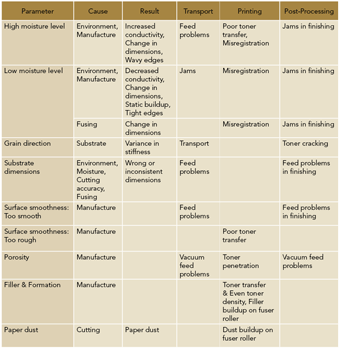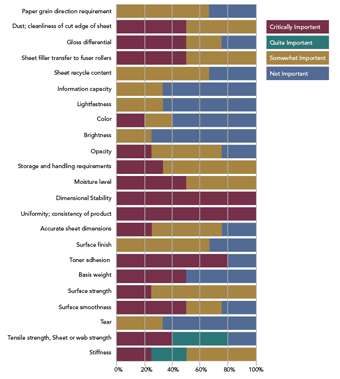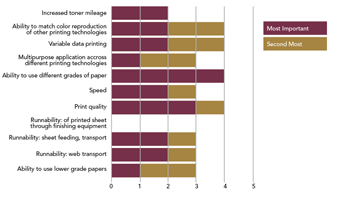This month’s research monograph, a survey-based study entitled A Survey of Digital Press Manufacturers: Critical Paper Characteristics (PICRM-2008-03), is authored by Howard Vogl, Visiting Professor at RIT’s School of Print Media. The purpose of this study was to identify constraints and potential solutions for improved performance and quality of digitally printed papers. From a device manufacturer standpoint, this research sought to understand the characteristics that are important to successful printing and the various elements that make up the total value proposition presented to print customers.
The scope of this research was limited to the high-end digital production market segment in North America. Research was limited to devices using electrophotographic technology. Inkjet technology, though rapidly growing in use, was considered to have different substrate challenges better addressed separately.
Background
Technology
In the last two decades, electrophotography has developed to the point where it is a legitimate alternative to analog print production technologies such as offset lithography. Electrophotography’s lack of a permanent image master provides unique advantages over analog printing methods, including reduced makeready and the ability to vary information from one page to the next. Several manufacturers have entered the production digital printing market because of these advantages.
The Relationship of Paper and Press
Both offset lithography and digital printing processes face substrate challenges. These challenges can be divided into four broad categories. First, the substrate must run through the press. Second, the substrate must accept the ink/toner, as well as the method of application, without undesirable effects. Third, the process must provide suitable image quality. Fourth, the printed piece must able to withstand the rigors it will be subjected to throughout its intended use.
Technical Considerations
Offset lithography faces numerous substrate challenges; however, there are unique differences in the role that substrates play in the digital printing processes. Since toner is deposited on the substrate primarily using electrostatic charges, both the design of the press and the conductivity of the substrate must be taken into account.
The moisture content of any substrate intended for digital printing is critical because moisture level affects the dielectric properties of the substrate. The moisture level must be low enough so that the substrate maintains its dielectric properties while holding a sufficient charge to enable toner transfer. However, substrate moisture level cannot be too low, as this will cause an excessive electrostatic charge that interferes with transport. On the other hand, if the moisture level is too high then the substrate will not be able to hold a sufficient charge, resulting in poor toner transfer. The substrate must also be able to hold the proper charge through the transfer phase. Therefore, electrophotographic devices must be designed to preserve optimal paper conductivity throughout the entire printing process.
Physical properties of the substrate can also lead to printing difficulties in electrophotography. Dimensional stability of the substrate during the printing process is closely associated to changes in moisture content, which can often be related to the fusing process. Dimensional stability during transport becomes critical in duplexing, since the substrate is cycled through the printing system a second time. The surface finish of the substrate is also important. Unlike lithography, where a liquid ink penetrates the surface of the substrate, toner must be drawn into the substrate by electrostatic charge with the assistance of physical mechanisms.
One of the most important concepts of digital printing is to produce a complete document, and the production of a complete document for an end user typically involves some form of finishing. Due to the fusing process, digitally printed sheets have lower moisture content than lithographically printed sheets. This can lead to increased static and sheet curl problems that interfere with finishing processes. Grain direction is another critical aspect of digital substrates because substrate stiffness has an affect on transport. It is a good printing practice to consider grain direction from the end use of the product back through any finishing steps, and then, to the print engine. However, at times the substrate grain will not be in the ideal direction for transport, and additional waste may be incurred to resolve the press and finishing conflicts. Table 1 summarizes the relationship between several common substrate properties, conditions that affect those properties, and digital press performance.
Table 1. Relationship of paper conditions to press performance
click to view image full size
Research Methodology
Manufacturers of high-end electrophotographic devices were surveyed. From a device manufacturer standpoint, this research sought to understand the characteristics that are important to successful printing and the various elements that make up the total value proposition presented to print customers. Specific research objectives were:
- To understand paper properties that limit innovation in printing devices.
- To identify and rate critical paper property requirements which constrain digital printer performance and quality.
- To determine the decision factors that, along with paper price, make up the total value proposition presented to print customers.
- To evaluate current and future digital printing industry technological trends, including printer technologies, consumer needs, and new market opportunities.
Survey Design
The survey consisted of structured questions regarding various paper properties that were thought to limit current performance or future innovation in digital devices. Respondents were asked to rank the most important paper properties that limit performance and innovation. Also, device manufacturers were asked to indicate the paper properties that were part of the total value proposition presented to customers when making the decision to purchase a digital press. Furthermore, general information was requested on the type of print jobs each manufacturer’s digital devices printed. Opportunity was provided for respondents to supply additional information not addressed by the survey questions. The survey was pilot tested at the RIT Printing Applications Laboratory and at several paper manufacturers.
Analysis of Findings
Universal Characteristics
All device manufacturers considered dimensional stability and uniformity of product to be substrate conditions that limit current device performance (see Figure 1). Increased uniformity of product must come from paper manufacturers. However, the question arises as to whether paper manufacturers can realistically increase uniformity of product with current papermaking technology. Also, the desire of printers for substrates that work across different technologies complicates the situation from both a technical and an economic standpoint.
Figure 1. Percent of respondents indicating degree of importance of specific paper characteristics
click to view image full size
Filler transfer to fuser rollers is another area that paper manufacturers need to address in order to increase the mean time between service calls. On the other hand, dimensional stability is a property that can, in part, be addressed by device manufacturers themselves. This is so because the fusing process—in particular when duplexing— plays a prominent role in dimensional stability.
Toner adhesion, while not universal in importance, was ranked as the most important paper property limiting performance (see Figure 2). Lack of universality can be explained by considering applications where good toner adhesion was not important. Based on the importance of toner adhesion, it was obvious that device manufacturers extend their definition of performance to include finishing and distribution because these steps are known to be abrasive to the printed substrate. Papers could be manufactured to improve toner bonding, but this would not improve abrasion to the image surface. It is more likely that the practical answer to abrasion in post-production processes lies in coating the printed sheet.
Figure 2. Ranking of critically important paper characteristics
click to view image full size
When asked about paper characteristics important to optimal toner application, paper surface resistivity and moisture level were almost universally important. Surface resistivity and moisture level play an important role in toner density and evenness. Since fusing energy is evenly distributed on the substrate surface, unexpected variations in toner density result in less than optimal fusing of toner to substrate. Therefore, optimal toner fusing is, in part, based on substrate uniformity.
Application-Specific Characteristics
Dimensional stability, product uniformity, and toner adhesion were considered critically important by all respondents. However, after these considerations the importance of specific paper characteristics quickly diverged. This divergence can in part be attributed to differences in the technology that specific device manufacturers use. Nevertheless, the basic assumption can be made that an owner of a production digital printer will select the device that is best suited for the market they wish to serve. Therefore, the primary factor for the diversity of critical paper characteristics can be attributed to the specific print application.
Value Expectations
Considering the number of elements considered important when presenting a value proposition to customers who purchase digital devices, it can be said that elements considered by most device manufacturers as critical represent a set of customer expectations for all digital presses (see Figure 3). On the other hand, elements that were not considered universally important to the value proposition but which were highly scaled could be considered expectations for devices intended for specific print applications.
Figure 3. Ranking of the critically important decision factors of printers when evaluating the purchase of a digital production press
click to view image full size
Variable Data Printing
As most research has indicated, there is great interest in variable data printing. However, the problems encountered with variable data goes beyond technical considerations, and involve those of presenting a compelling value proposition to print buyers and training staff to sell and produce variable data products. Therefore, the importance of variable data capability might be based on customers’ future, rather then current, needs.
Post Production
While sheet runnability through finishing equipment was considered a critical factor of the value proposition presented to customers, it was overshadowed by considerations such as runnability, print quality, print speed, ability to use different paper grades, and matching Pantone colors. This apparent lack of importance attributed to finishing runnability could be due to the background of those interviewed, or it could indicate that device manufacturers consider runnability through finishing equipment to be an area outside their responsibility.
This rated lack of importance, when considered in light of the relatively high importance of more automated finishing operations, may indicate a desire on the part of device manufacturers to add automated finishing to digital devices.
Conclusion
Possibly the most significant finding is that there is no best set of paper characteristics for production digital presses. With the exceptions of dimensional stability and uniformity of product, there are many ‘right kinds’ of digital paper based on the application being run.
Likewise, there is no one best value proposition to present to customers. Instead, there are multiple value propositions based on specific print applications. For example, a customer that intends to use a digital printer to compete with short-run commercial offset printing might consider matching Pantone colors as critical to the value proposition, while a customer who intends to print variable data direct mail pieces may consider sheet transport to be the most critical variable. Therefore, both the paper characteristics and the value proposition presented to customers who purchase production digital presses must be tailored to their specific needs.
Limitations of the Study
The small sample size caused exaggerations in data ranges. For example, if a single respondent considered a particular attribute unimportant, it significantly downgraded the entire results for that category.
As with any set of questions requiring structured responses, each respondent is left to their own interpretation of meaning. One respondent might consider sheet uniformity based on the even application of toner on the sheet, while another might consider uniformity as measured surface resistivity.
Also, respondents were considered to have expertise in the areas addressed by the survey. However, due to the range of questions, it is likely that some questions were answered by individuals with limited knowledge in a particular area.
2007-2008 Research Monographs:
To read about this research in detail, download the monograph from: http://print.rit.edu/pubs/picrm200803.pdf
This article from the Printing Industry Center at RIT was originally published in the Centers affiliate-only eReview newsletter. Article Series Index.
About the Printing Industry Center at RIT
Dedicated to the study of major business environment influences in the printing industry brought on by new technologies and societal changes, the Printing Industry Center at RIT addresses the concerns of the printing industry through research initiatives and educational outreach. The Center creates a forum for printing companies and associations worldwide to access a neutral platform for the dissemination of knowledge that can be trusted by the industry, to share ideas, and to build the partnerships needed to sustain growth and profitability in a rapidly changing market.
Research publications of the Center are available at: http://print.rit.edu/research/


















